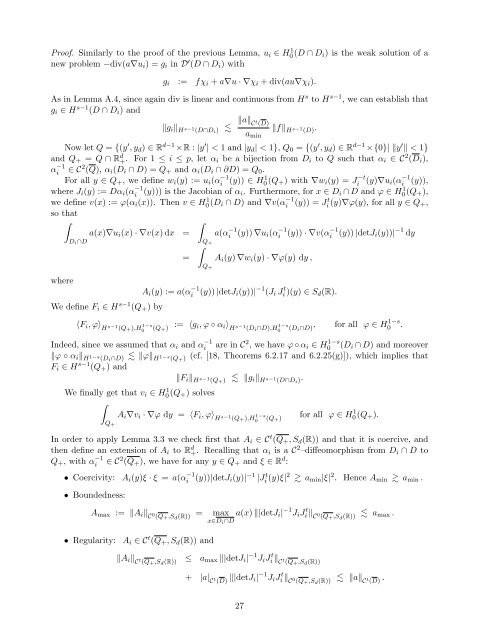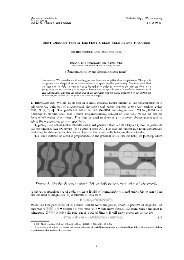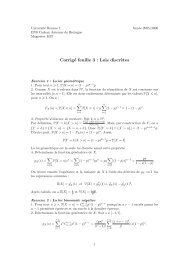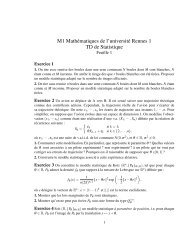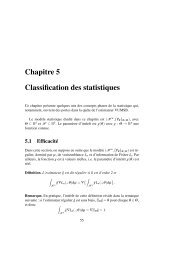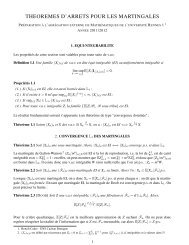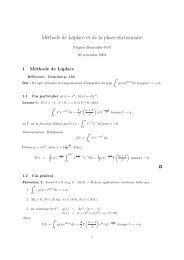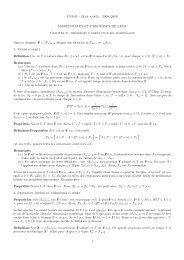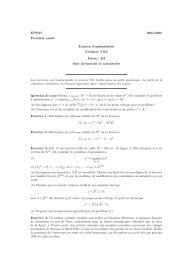Bath Institute For Complex Systems - ENS de Cachan - Antenne de ...
Bath Institute For Complex Systems - ENS de Cachan - Antenne de ...
Bath Institute For Complex Systems - ENS de Cachan - Antenne de ...
You also want an ePaper? Increase the reach of your titles
YUMPU automatically turns print PDFs into web optimized ePapers that Google loves.
Proof. Similarly to the proof of the previous Lemma, u i ∈ H 1 0 (D ∩ D i) is the weak solution of anew problem −div(a∇u i ) = g i in D ′ (D ∩ D i ) withg i := fχ i + a∇u · ∇χ i + div(au∇χ i ).As in Lemma A.4, since again div is linear and continuous from H s to H s−1 , we can establish thatg i ∈ H s−1 (D ∩ D i ) and‖g i ‖ H s−1 (D∩D i ) ‖a‖ C t (D)a min‖f‖ H s−1 (D).Now let Q = {(y ′ , y d ) ∈ R d−1 ×R : |y ′ | < 1 and |y d | < 1}, Q 0 = {(y ′ , y d ) ∈ R d−1 ×{0}| ‖y ′ ‖ < 1}and Q + = Q ∩ R d +. <strong>For</strong> 1 ≤ i ≤ p, let α i be a bijection from D i to Q such that α i ∈ C 2 (D i ),αi −1 ∈ C 2 (Q), α i (D i ∩ D) = Q + and α i (D i ∩ ∂D) = Q 0 .<strong>For</strong> all y ∈ Q + , we <strong>de</strong>fine w i (y) := u i (αi−1 (y)) ∈ H0 1(Q +) with ∇w i (y) = Ji−t (y)∇u i (αi−1 (y)),where J i (y) := Dα i (αi −1 (y))) is the Jacobian of α i . Furthermore, for x ∈ D i ∩ D and ϕ ∈ H0 1(Q +),we <strong>de</strong>fine v(x) := ϕ(α i (x)). Then v ∈ H0 1(D i ∩ D) and ∇v(αi −1 (y)) = Ji t(y)∇ϕ(y), for all y ∈ Q +,so that∫∫whereD i ∩Da(x)∇u i (x) · ∇v(x) dx =We <strong>de</strong>fine F i ∈ H s−1 (Q + ) by=∫a(αi−1Q +(y)) ∇u i (α −1iQ +A i (y) ∇w i (y) · ∇ϕ(y) dy ,A i (y) := a(αi−1 (y)) |<strong>de</strong>tJ i (y))| −1 (J i Ji t )(y) ∈ S d (R).(y)) · ∇v(α −1 (y)) |<strong>de</strong>tJ i (y))| −1 dy〈F i , ϕ〉 H s−1 (Q + ),H 1−s0 (Q + ):= 〈g i , ϕ ◦ α i 〉 H s−1 (D i ∩D),H 1−s0 (D i ∩D), for all ϕ ∈ H1−s 0 .In<strong>de</strong>ed, since we assumed that α i and αi−1 are in C 2 , we have ϕ ◦ α i ∈ H0 1−s (D i ∩ D) and moreover‖ϕ ◦ α i ‖ H 1−s (D i ∩D) ‖ϕ‖ H 1−s (Q + ) (cf. [18, Theorems 6.2.17 and 6.2.25(g)]), which implies thatF i ∈ H s−1 (Q + ) and‖F i ‖ H s−1 (Q + ) ‖g i ‖ H s−1 (D∩D i ).We finally get that v i ∈ H 1 0 (Q +) solves∫Q +A i ∇v i · ∇ϕ dy = 〈F i , ϕ〉 H s−1 (Q + ),H 1−s0 (Q + )for all ϕ ∈ H 1 0 (Q + ).In or<strong>de</strong>r to apply Lemma 3.3 we check first that A i ∈ C t (Q + , S d (R)) and that it is coercive, andthen <strong>de</strong>fine an extension of A i to R d +. Recalling that α i is a C 2 –diffeomorphism from D i ∩ D toQ + , with α −1i∈ C 2 (Q + ), we have for any y ∈ Q + and ξ ∈ R d :• Coercivity:• Boun<strong>de</strong>dness:A i (y)ξ · ξ = a(α −1i(y))|<strong>de</strong>tJ i (y)| −1 |J t i (y)ξ|2 a min |ξ| 2 . Hence A min a min .A max := ‖A i ‖ C 0 (Q + ,S d (R)) = max a(x) ‖|<strong>de</strong>tJ i | −1 J i Ji t ‖ Cx∈D i ∩D0 (Q + ,S d (R)) a max .i• Regularity:A i ∈ C t (Q + , S d (R)) and‖A i ‖ C t (Q + ,S d (R))≤ a max ‖|<strong>de</strong>tJ i | −1 J i J t i ‖ C t (Q + ,S d (R))+ |a| C t (D) ‖|<strong>de</strong>tJ i| −1 J i J t i ‖ C 0 (Q + ,S d (R)) ‖a‖ C t (D) .27


